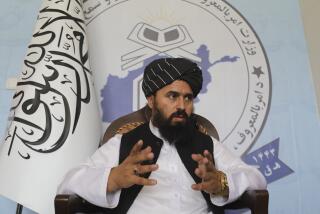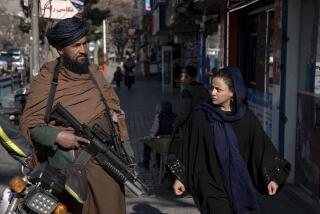A Maker of Burkas Will Have to Find a New Line of Work
- Share via
MAZAR-I-SHARIF, Afghanistan — If there was one person poised to make a fortune off the Taliban, it was Mohammed Isaq.
When Isaq’s fabric import business foundered in 1990, he scraped together what he had left and took refuge in an Afghan niche market: burkas.
At the time, few women in northern Afghanistan wore a burka, known locally as farangi, which covers from head to toe and leaves only a screen for the eyes. In Mazar-i-Sharif, perhaps the most Western-leaning and liberal city in Afghanistan, the market consisted only of a few older men who came to town to buy them for their wives in small, conservative villages.
But a few years after Isaq started sewing them, the Taliban made the burka mandatory for all Afghan women--and handed him a golden business opportunity.
Isaq acknowledges that business was brisk for a few years, especially after the Taliban seized Mazar-i-Sharif in 1998 and forced women here to don burkas. For the next three years, men would arrive from all over northern Afghanistan and buy 100 or 200 burkas at a time for resale in more remote regions.
But when the Taliban was forced out of the city last month, the 45-year-old ethnic Tajik was one of the first to express his pleasure by shaving his beard.
“The Taliban did no good, not for me,” he explained, holding his hand at the top of his chest to show how long his beard had been. “Sure, I had an income, but everything else was so expensive that I didn’t make any money.”
The Taliban cut off Afghanistan from the rest of the world, including international markets. Mazar-i-Sharif had been a major trading center, with goods shipped from Russia and Uzbekistan, whose border is just 40 miles away. But after the Taliban took over, Uzbekistan sealed the border and prices for most goods skyrocketed. Under the Islamic regime, the more money Isaq made, the more he had to spend.
‘It Was Just Business,’ Entrepreneur Insists
Isaq insists that he didn’t make and sell burkas out of any ideological conviction. “It was just business,” he said. “I didn’t think about whether I was helping the Taliban or not.”
The burka is an awkward garment. It swathes even the hands, one of which is often held at chin level, trying to pull the screen close enough to the eyes to see out. Women wearing them walk with a distinctive nod--peering toward the feet, trying to see them beneath the folds as they negotiate across and around puddles, gutters and litter.
It takes seven yards of fabric to make a burka, Isaq says. The fabric for the rear panel is crimped with a special iron into tiny pleats and sewn onto a small cap that sits on top of the head. The front outer panel, which falls past the eyes and stops above the knees, is usually decorated with floral stitching.
Most burkas are white or periwinkle blue. “It depends on a woman’s age,” Isaq explained. “White is for young women. Older women like the blue because it doesn’t show the dirt so much.”
Isaq has stopped selling a third color: olive green. “No one likes it. I never sell any.”
Isaq’s shop is a tiny, closet-like space tucked into a narrow alley crammed with pushcarts and kiosks in the city’s central bazaar. The shop is essentially a 6-foot-by-12-foot shipping container, raised off the ground on cinder blocks with one end open to the alley. It gets little sunlight, lighted instead by a purplish florescent light that makes even the white burkas glow blue.
The burkas hang by the dozens. The cheapest, of Pakistani polyester, cost about $5 each. The more expensive, of Korean polyester, can run for as much as $30.
Isaq’s store supports three extended households. He has hired two neighbor families--the first cuts and crimps the rear panel, the second prepares the front panel, inserting the screen and stitching the decoration. His own family, including three teenage daughters, sews the pieces together.
“My work feeds about 40 or 50 people,” he said proudly.
Although it has been a month since the Taliban left, the women of Mazar-i-Sharif are still wearing burkas. They say it is still too soon since the Taliban left to expose themselves publicly, both literally and figuratively.
But they are slowly chipping away at other Taliban-era restrictions. They are walking in the street unaccompanied by a male relative. They are wearing high-heeled shoes. They are shopping on their own in the bazaar.
It’s only a matter of time before the women of Mazar-i-Sharif shed their burkas and his business goes under, Isaq says. He thinks that it will last at most a few more months. Like others here, he believes that the watershed will come in March, when a new Afghan school year begins. He expects that the female students and teachers will leave their burkas at home.
Three of the first burka-liberated women will be his daughters, he says, who will leave the family workshop and resume their studies. “When school begins, they will go without farangi,” he said.
Isaq expresses little dismay at the impending loss of his livelihood. Indeed, it is hard to find anyone in this city who regrets the passing of the Taliban, even those who presumably benefited the most.
“My business will die because women will start walking around open-faced,” he said without sadness. “I will just have to find something else to do.”
More to Read
Sign up for Essential California
The most important California stories and recommendations in your inbox every morning.
You may occasionally receive promotional content from the Los Angeles Times.












